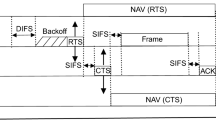Abstract
It is well known that 802.11 suffers from both inefficiency and unfairness in the face of competition and interference. This paper provides a detailed analysis of the impact of topology and traffic type on network performance when two flows compete with each other for airspace. We consider both TCP and UDP flows and a comprehensive set of node topologies. We vary these topologies to consider all combinations of the following four node-to-node interactions: (1) nodes unable to read or sense each other, (2) nodes able to sense each other but not able to read each other’s packets and nodes able to communicate with (3) weak and with (4) strong signal. We evaluate all possible cases through simulation and show that the cases can be reduced to 9 UDP and 10 TCP 802.11 g models with similar efficiency/fairness characteristics. We also validate our simulation results with extensive experiments conducted in a laboratory testbed. These more detailed models improve on previous work such as hidden-/exposed-terminal categorization and are thus better suited as a basis for adaptive techniques to improve performance in 802.11 multi-hop WLAN or Mesh Networks.
Similar content being viewed by others
Explore related subjects
Discover the latest articles, news and stories from top researchers in related subjects.References
Bharghavan V, Demers A, Shenker S, Zhang L. MACAW: A media access protocol for wireless LANs. In Proc. SIG-COMM’04, London, UK, Aug. 1994, pp.212–225.
Karn P. MACA: A new channel access method for packet radio. ARRL/CRRL Amateur Radio. In Proc. 9th Computer Networking Conference, London, UK, Apr. 1990, pp.134–140.
Bharghavan V. Performance evaluation of algorithms for wireless medium access. In Proc. IPDS’98, Durham, North Carolina, USA, Sep. 1998, pp.142–149.
Chen C C, Luo H. The case for heterogeneous wireless Macs. In Proc. HotNets’05, College Park, Maryland, USA, Nov. 2005.
Henderson T, Kotz D, Abyzov I. The changing usage of a mature campus-wide wireless network. In Proc. MobiCom’04, Philadelphia, Pennsylvania, USA, Sep. 2004, pp.187–201.
Garetto M, Shi J, Knightly E W. Modeling media access in embedded two-flow topologies of multi-hop wireless networks. In Proc. MobiCom’05, Cologne, Germany, Aug. 2005, pp.200–214.
Deng J, Liang B, Varshney P K. Tuning the carrier sensing range of IEEE 802.11 MAC. In Proc. GLOBECOM’04, Dallas, Texas, USA, Nov. 2004, pp.2987–2991.
Xu K, Gerla M, Bae S. How effective is the IEEE 802.11 RTS/CTS Handshake in Ad Hoc Networks. In Proc. GLOBECOM’02, Taipei, Nov. 2002, pp.72–76.
Jamieson K, Hull B, Miu A, Balakrishnan H. Understanding the real-world performance of carrier sense. In Proc. E-WIND’05, Philadelphia, Pennsylvania, USA, Aug. 2005, pp.52–57.
Zhai H, Fang Y. Physical carrier sensing and spatial reuse in multirate and multihop wireless ad hoc networks. In Proc. INFOCOM’06, Barcelona, Catalunya, Spain, Apr., 2006, pp.1–12.
Yang X, Vaidya N H. On the physical carrier sense in wireless ad-hoc networks. In Proc. INFOCOM’05, Miami, USA, Mar. 2005, pp.2525–2535.
Tan G, Guttag J. Long-term time-share guarantees are necessary for wireless LANs. In Proc. SIGOPS European Workshop, Leuven, Belgium, Sep. 2004, p.35.
Vaidya N H, Bahl P, Gupta S. Distributed fair scheduling in a wireless LAN. In Proc. MobiCom’00, Boston, Massachusetts, United States, Aug. 2000, pp.167–178.
Ju H-J, Rubin I, Kuan Y C. An adaptive RTS/CTS control mechanism for IEEE 802.11 MAC protocol. In Proc. VTC’03, Apr. 2003, pp.1469–1473.
Talucci F, Gerla M, Fratta L. MACABI (MACA by invitation): A receiver oriented access protocol for wireless multiple networks. In Proc. PIMRC’97, Helsinki, Finland, Sep. 1994, pp.1–4.
Kim H, Hou J C. Improving protocol capacity with model-based frame scheduling in IEEE 802.11-operated WLANs. In Proc. MobiCom’03, San Diego, CA, USA, Sep. 2003, pp.190–204.
Sadeghi B, Kanodia V, Sabharwal A, Knightly E. Opportunistic media access for multirate ad hoc networks. In Proc. MobiCom’02, Atlanta, Georgia, USA, Sep. 2002, pp.24–35.
Bianchi G. Performance analysis of the IEEE 802.11 distributed coordination function. IEEE Journal on Selected Areas in Communications, 2000, 18(3): 535–547.
Zhai H, Kwon Y, Fang Y. Performance analysis of IEEE 802.11 MAC protocols in wireless LANs. Wireless Communications and Mobile Computing, Special Issue on Emerging WLAN Technologies and Applications, 2004, 4: 917–931.
Gupta N, Kuman P R. A performance analysis of the 802.11 wireless lan medium access control. Communications in Information and Systems, 2004, 3(4): 279–304.
Kim H, Hou J C. A fast simulation framework for IEEE 802.11-operated wireless LANs. In Proc. SIGMETRICS’04, New York, NY, USA, Jun. 2004, pp.143–154.
Zeng X, Bagrodia R, Gerla M. GloMoSim: A library for parallel simulation of large-scale wireless networks. In Proc. PADS’98, Banff, Alberta, Canada, May 1998, pp.154–161.
Cai K, Feeley M J, George S J. Understanding performance for two 802.11b competing flows. Technical Report TR–2007–09, Department of Computer Science, University of British Columbia, Apr. 2007.
IEEE Std 802.11 g – 2003. Ammendment to IEEE Std 802.11. 1999 Edition (Reaff 2003)), the Institute of Electrical and Electronics Engineers, New York, NY, USA, 2003.
Author information
Authors and Affiliations
Corresponding author
Rights and permissions
About this article
Cite this article
Cai, K., Feeley, M.J., Cully, B. et al. Understanding Performance for Two 802.11 Competing Flows. J. Comput. Sci. Technol. 23, 365–376 (2008). https://doi.org/10.1007/s11390-008-9139-6
Revised:
Published:
Issue Date:
DOI: https://doi.org/10.1007/s11390-008-9139-6




